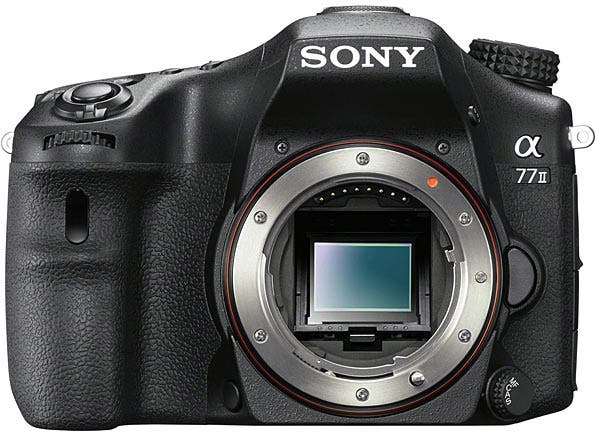
The Sony Alpha A77 Mark II is the first new A-mount translucent mirror DSLR camera Sony has introduced in over a year, scotching rumors that the mount was being abandoned for the E-Mount format. The A77 MII sports a new 24MP sensor, improved autofocusing, with faster AF speed, a new BIONZ X image processor, and a 12fps burst rate.
The Sony Alpha 77 Mark II will be available in June for $1,198 body only or $1,798 with the Sony 16-50mm f/2.8 DT zoom lens. Adorama is accepting pre-orders now. Orders will be fulfilled on a first-come, first-served basis; credit cards will not be charged until orders ship.

Let’s take a closer look at the Sony A77 Mark 2:
Sony A77 Mark II: Key features
- 24.3MP APS-C CMOS sensor
- New BIONZ X Image Processor
- 79 phase detection AF points, 15 cross-type points
- Autofocus tracking
- Lock-on AF
- AF range control
- Eye AF
- Tilt-swivel LCD
- Built-in Image Stabilization
- Built-in Wi-Fi, NFC
- Full 1080 HD video in 60p, 60i, and 24p
- Rugged, weather-resistant magnesium alloy body
Sony A77 Mark II vs. A77: Key Improvements
- New sensor
- Maximum ISO now 25,600 vs. 16,000, boostable to 51,200 vs. 25,600
- 79 AF points, 15 cross type, vs. 19 AF points, 11 cross-type
- Higher-resolution LCD monitor (1228k vs. 921k dots)
- Wi-Fi NFC added

The Sony A77 Mark II is the most advanced APS-sensor DSLR Sony makes. It’s a mash-up of pro-level high-performance and the affordability that comes with having an APS-C sensor. Sony claims the 79-point AF system, which includes 15 cross-type sensors, is the most AF points in a DSLR, made possible by the use of the translucent mirror rather than a traditional DSLR design. A new BIONZ-X image processing engine is said to offer the best resolving power and sensitivity in class.
The Sony A77 Mark II in depth
Burst Rate
At 12fps at full resolution, Sony says the A77 Mark II’s continuous shooting speed is the fastest in its class, and it is said to even outperform more expensive rivals. When shooting 12fps at full resolution the camera can capture up to 60 frames in a single burst in JPEG, assuming an appropriately fast memory card is being used.
 Autofocus System
Autofocus System
Sony spread the camera’s 79 phase detection points across the entire field of coverage, concentrating all 15 cross-type sensors in the most frequently used central area. According to Sony, this arrangement helps the A77 Mark II achieve accurate focusing even with horizontally striped subjects, which line-type AF points typically find challenging. The camera allows you to enlarge the image to aid in focusing.
The new AF system also performs well in low-light conditions—as low as EV -2 (ISO 100), which is similar to a moonlit night under which objects are difficult to see even with the naked eye. The new AF algorithm instantly recognizes and reliably tracks the desired subject. The A77 Mark II also realizes impressive focusing accuracy, even when a large-aperture lens is mounted, thanks to the f/2.8 AF point placed horizontally in the center of the AF sensor overlapping another AF point, according to Sony.
New Sensor and Processor
Sony added new 24.3MP APS-C sensor that uses the same gapless on-chip lens structure as the α7R and features the latest-generation RGB color filter and other cutting-edge device technologies developed by Sony. Sony claims 20% higher sensitivity and lower noise levels compared to the original A77, throughout its entire sensitivity range from ISO 100-25,600. In fact, the BIONZ X image processing engine is the same one being used on the full-frame Sony A7 and A7R. Sony claims this engine’s processing speed has been tripled over the previous version.
Sony says it has introduced area-specific noise reduction to effectively suppress noise from corner to corner while maintaining as much detail as possible.
Details, Details
Sony has paid attention to detail in images. The A77 Mark II is said to have been tweaked to minimize overly hard outlines which are common of digital images for a more natural, three-dimensional appearance that more closely reflects human vision. Sony has also employed software-based diffraction reducing technology to maximize optical performance of lenses for finer detail when shooting with smaller apertures. The result, according to Sony, is finely-detailed images, even when shooting with smaller apertures.
Wireless Connectivity Simplified
Connecting with smartphones can be a challenge. Sony says they have worked on simplifying image sharing via the A77 Mark II’s built-in Wi-Fi and NFC technology. Tap the camera to another NFC-enabled device and photos are transferred with one touch. Users can also operate the camera’s shutter remotely via the Smart Remote Control app.
Solid Body
Like the full-frame A99, the A77 Mark II is constructed of rugged magnesium alloy. Sealing around the main buttons, dials, ports and doors is weather-resistant with a double-layered structure that enhances sealing effectiveness at all camera body openings including the media compartment and terminal area. The same high-level resistance to dust and moisture is maintained even when the camera is mounted with the 16-50mm F2.8 kit zoom lens.
Viewfinder, LCD Details
The A77 Mark II features the same 2.359k resolution OLED electronic viewfinder as its predecessor, and a 3-inch TFT LCD monitor with 1.228k dot resolution. It can be tilted up or down for selfies, hail-Mary’s and low-angle shots. Full-time LiveView is available in either LCD or EVF.
Other Details
The camera has a built-in flash with a Guide Number of 12, and is also wireless-flash-ready. With 11 customizable buttons that can be assigned any of 53 functions, and the ability to customize the information display, the Sony A77 Mark II is one of the most customizable cameras on the market. Memory Recall lets users select up to 3 sets of memory quickly.





